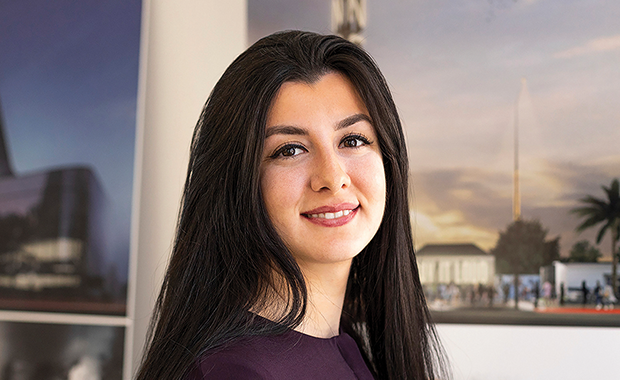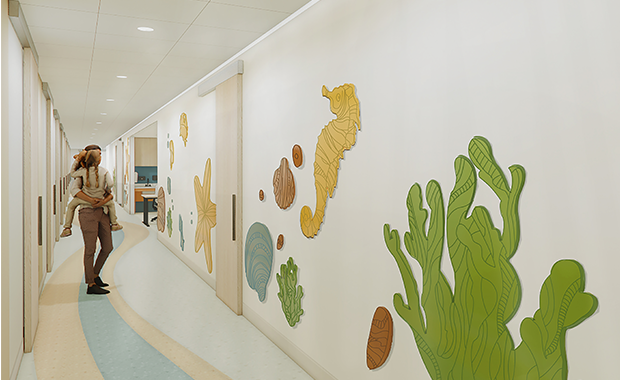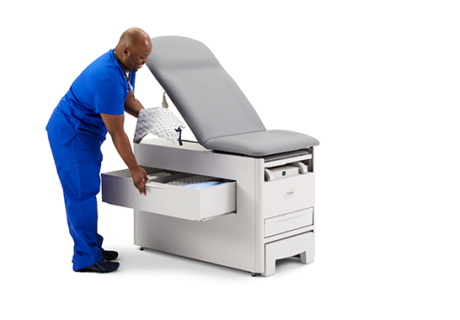HCD Rising Star: Yasmeen Barakat
Yasmeen Barakat, LEED AP BD+C, Medical Planner, Perkins&Will (Los Angeles)
Yasmeen Barakat received a Bachelor of Science in architecture from a German Jordanian university in Jordan and Germany and later continued her studies at Southern Illinois University. Having passed her Architect Registration Examination, she’s working toward her licensure and holds LEED AP BD+C accreditation.
Joining Perkins&Will in 2022 as a medical planner, she’s already making a mark, having demonstrated her ability to handle a range of projects with various clients simultaneously as well as roles, whether as a medical planner, interior designer, or project designer with technical knowledge.
One of her recent projects is the Jiahui International Hospital, a new ground-up 1 million square-foot, base-isolated hospital project in in Beijing, China, that features a full range of services. As a medical planner on the project, she’s been responsible for the planning concepts for various departments and completing detailed plans.
Under the guidance of the firm’s practice leaders, Barakat developed standardized clinical module scenarios that will become the basis for establishing standards and templates for the healthcare system’s current and future projects.
She’s also shown her skills at pivoting when changes arise on a project. For example, during the proposal presentation for the cancer center and infusion clinic at Jiahui International Hospital, the client quickly decided to completely change the location of the clinic within the medical center.
Within 24 hours, Barakat came up with two new options for the department that demonstrated a highly improved concept. The client quickly signed off on a new approach, enabling the whole team to move forward on the project without any delay in the schedule.
She also excels at switching between various roles. For example, on a recent renovation of a rehabilitation hospital for Encompass Health in Bakersfield, Calif., she served as interior designer, closely studying client facility standards and implementing them while bringing new and creative solutions that resulted in a pleasant and safe environment on the project.
For her work at a Department of Veterans Affairs (VA) ambulatory care center planning study in Northern California, she and her team worked closely with the structural team to come up with innovative solutions, including developing space where none of the treatment rooms had any structural obstructions. This resulted in an entirely consistent experience both for staff and patients.
In addition to her project work, Barakat serves as a Justice, Equity, Diversity & Inclusion (JEDI) Champion in Perkins&Will’s Los Angeles studio and nurtures inclusivity as a key driver in designing future healthcare environments.
Her desire to learn, curiosity, and ability to deliver creative solutions set her apart. She’s on the path to becoming an expert in the field as well as an innovator who can bridge strict norms and regulations with a creative vision that results in new and innovative design solutions to help drive the industry forward.
Path to healthcare design: Healthcare design found me. When I moved to the U.S. five years ago from Jordan, my aspirations to advance my career in architecture led me to a role at a healthcare design studio. I soon realized that I was drawn to healthcare planning and design and found the challenges it presented to be fulfilling. Despite briefly contemplating diversifying my portfolio, the sense of fulfilment I felt from healthcare design was unparalleled. The satisfaction of each day’s work reinforced my belief in impactful, purpose-driven work. This conviction drives me, affirming that meaningful work is the ultimate pursuit.
Describe your design approach: Holistic and empathetic approach, by considering user experiences and interconnected elements.
On your desk now: I’m focusing on two primary projects: The first is the Jiahui International Hospital project in Beijing, China. I’ve been engaged since the schematic phase, and I am currently involved in the design development phase, collaborating with user groups and finalizing room layouts along with completing comprehensive departmental planning. The project gives me a broader global perspective, allowing me to embrace diverse healthcare practices and accommodate unique user needs. The second project is a pediatrics medical office building tenant improvement project for Santa Barbara Cottage Hospital in Santa Barbara, Calif. My engagement began in the early design development phase, and I am now progressing into construction administration. Crafting a playful, comforting space for children facing medical visits brings me immense joy. I can’t wait to see it built!
Most rewarding project to date: For the first few years of my career, I worked mostly with the VA, serving those who’ve dedicated their lives to serving their country. I found this profoundly fulfilling.
What success means to you: By creating and contributing to environments that hold purpose, I find fulfillment in making a tangible, positive difference.
Industry challenge on your radar: Urgently, the healthcare design industry must advance sustainable, eco-conscious practices to mitigate the impact of facilities on the environment. Given the complexities inherent in healthcare design, such as regulatory requirements, infection control, budget constraints, and energy intensity to name a few, the challenge of advancing sustainable practices is particularly difficult. I’m committed to progressive sustainable design, and I look forward to ingenious solutions from the healthcare design industry, as we work together to forge a future where healing environments harmonize seamlessly with environmental stewardship.
Must-have skill for healthcare designers today: Firstly, a deep understanding of the intricacies of healthcare environments, grasping patient needs, medical workflows, regulatory requirements, and specialized spaces. Secondly, the ability to look at design challenges in a holistic way, especially for large-scale projects due to the integration of complex systems, sustainability and resource efficiency, the patient-centric focus of healthcare environments, and interdisciplinary collaboration among the various stakeholders. This can be accomplished by walking in the shoes of patients, families, and healthcare providers, considering their specific needs and experiences.
For more on the 2023 HCD Rising Stars, read here.




